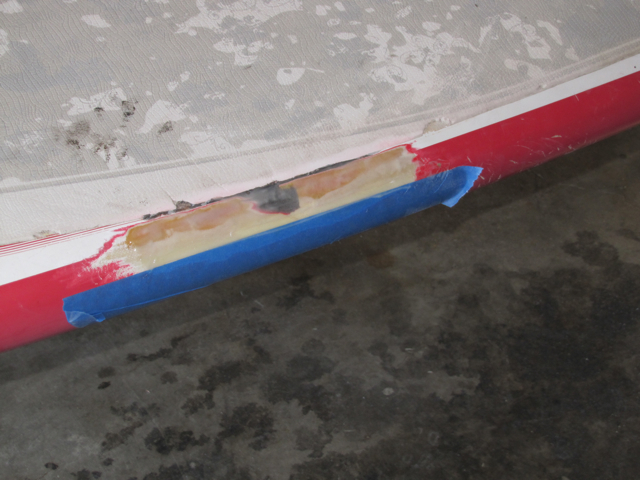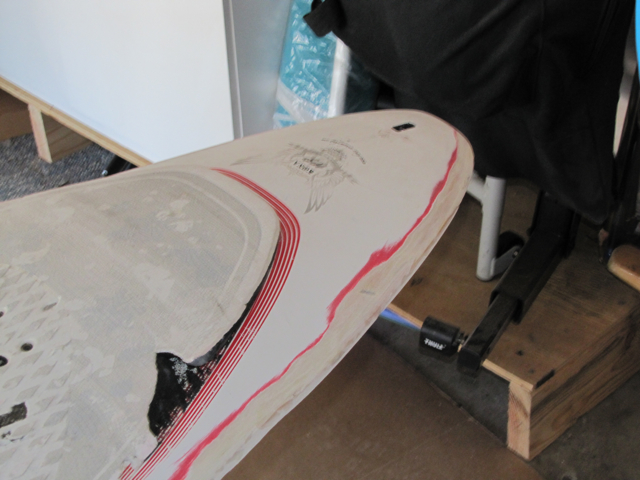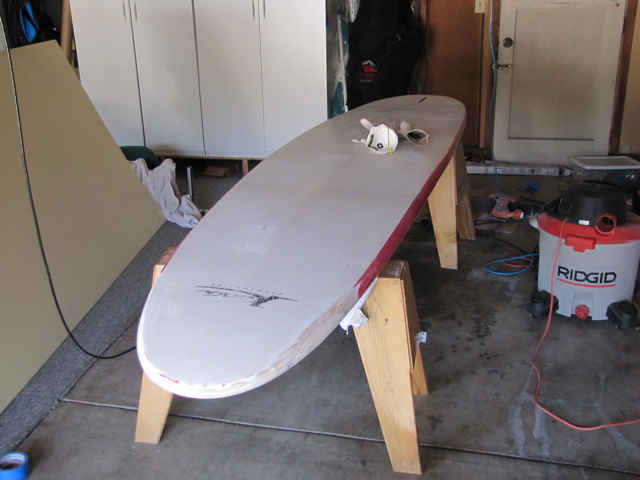| View previous topic :: View next topic |
| Author |
Message |
LUCARO
Joined: 07 Dec 1997
Posts: 661
|
 Posted: Fri Jul 09, 2010 1:04 am Post subject: Fiber glass/board repair help Posted: Fri Jul 09, 2010 1:04 am Post subject: Fiber glass/board repair help |
 |
|
How successfully can a new layer of fiberglass be layered over existing cured glass?
Am i required to grind down all the glass to the Divinycell underneath or can i just go over the old layers?
|
|
| Back to top |
|
 |
DanWeiss
Joined: 24 Jun 2008
Posts: 2296
Location: Connecticut, USA
|
 Posted: Fri Jul 09, 2010 7:37 am Post subject: Posted: Fri Jul 09, 2010 7:37 am Post subject: |
 |
|
Without getting to technical, you can laminate over old glass without removing it. Whether you want to is determined by any number of factors, mostly relating the the condition of the laminate to which you wish to add.
Basic stuff applies. Sand the surface of the fiberglass laminate enough to "key" it for the new layers. Clean the old surface with an appropriate solvent. Tack cloth the dust. Don't try to laminate on top of paint.
|
|
| Back to top |
|
 |
swchandler
Joined: 08 Nov 1993
Posts: 10588
|
 Posted: Fri Jul 09, 2010 1:20 pm Post subject: Posted: Fri Jul 09, 2010 1:20 pm Post subject: |
 |
|
"Tack cloth the dust."
Dan, I have to question the use of a tack cloth. I can say from experience that use of a tack cloth when working with polyester resin is a really big mistake. You don't want to visit that nightmare. Maybe epoxy is different, but I would tend to doubt it.
To get the best results after sanding, I've found that you want a clean surface devoid of any dust or oils, to include fingerprints. Acetone is an excellent degreaser, but I try not to use it unless it's really necessary, and if I do, I use it very sparingly. The prep process that works best for me to remove dust is a sponge and water. Also, I've found that a toothbrush and water can be a handy tool to remove the dust in pinholes. I usually go through process two to three times to ensure a dust free surface.
|
|
| Back to top |
|
 |
bred2shred
Joined: 02 May 2000
Posts: 989
Location: Jersey Shore
|
 Posted: Fri Jul 09, 2010 1:56 pm Post subject: Posted: Fri Jul 09, 2010 1:56 pm Post subject: |
 |
|
Blow off the dust with compressed air or suck off with a shop vac after sanding. Then clean the surface with acetone or rubbing alcohol. Once you've cleaned the surface, don't touch it with bare hands.
You can laminate directly on top of the damaged glass, but it is a matter of asthetics. For any repair, you want to replace the damaged fibers with at least the same number of layers that were originally there. If you don't sand the surface down (at a taper), then you will end up with a "lump" where the repair is. It can still be plenty strong this way, it just won't look perfect.
sm
|
|
| Back to top |
|
 |
keycocker
Joined: 10 Jul 2005
Posts: 3598
|
 Posted: Fri Jul 09, 2010 3:42 pm Post subject: Posted: Fri Jul 09, 2010 3:42 pm Post subject: |
 |
|
| If the top lamination is a piece of old sail window you can make a decent transition. Lay down just like cloth and squeegee out the extra resin.When you peel it the surface needs almost no sanding. If you don't do this you still shouldn't sand it through any glass layers no matter how bad it looks. Cutting through the layers ruins the strength.Epoxy and few layers is better than polyester and more layers because the resin adds strength and adheres better. It costs more but you don't use that much for a repair.
|
|
| Back to top |
|
 |
keycocker
Joined: 10 Jul 2005
Posts: 3598
|
 Posted: Fri Jul 09, 2010 3:44 pm Post subject: Posted: Fri Jul 09, 2010 3:44 pm Post subject: |
 |
|
Use cloth not mat
.Mat is sometimes used as top layer because it is no loss to sand it off.
|
|
| Back to top |
|
 |
bred2shred
Joined: 02 May 2000
Posts: 989
Location: Jersey Shore
|
 Posted: Fri Jul 09, 2010 5:21 pm Post subject: Posted: Fri Jul 09, 2010 5:21 pm Post subject: |
 |
|
| keycocker wrote: | | Epoxy and few layers is better than polyester and more layers because the resin adds strength and adheres better. |
For 95% of the boards out there, you should NEVER use polyester resin. You will melt the (polystyrene?) core. If the board is an epoxy board (and most are) you should only repair using epoxy resin.
sm
|
|
| Back to top |
|
 |
LUCARO
Joined: 07 Dec 1997
Posts: 661
|
 Posted: Fri Jul 09, 2010 7:02 pm Post subject: Posted: Fri Jul 09, 2010 7:02 pm Post subject: |
 |
|
thanks guys for the tips
The board is pictured below. I just got it for a good price as it was in pretty bad shape. apparently it had come off a car roof while driving home. Repairs had been done by previous owner and he used it for a year at least. Some of the repairs were looking dubious so i thought i might have a crack at fixing it. A learning experience at the very least and its been very enjoyable so far.
I did much reading on the board ladies site and have made multiple trips to ship chandlers for supplies (more $ on supplies than i paid for the board). Any way as you can see from below i have completed a few steps
1) laminating divinycell in damaged areas
1.5) sanding down d-cell to match contours
2) used some q-cell to create a bog to fill some small areas
next comes (at least what i am planing on doing)
3) sanding down the Q cell
4) glassing over repair areas ( i was thinking 2 layers of glass most areas but probably just 1 layer on the very front of the nose where i did not grind down int the glass and that side ding near the deck pad
5) using a fairing compound to smooth out the glass job
6) unsure if it needs a layer of paint to protect epoxy from uv
If you have any tips for # 4 or # 6 or anything else i would appreciate it.
| Description: |
|
| Filesize: |
296.76 KB |
| Viewed: |
15398 Time(s) |

|
| Description: |
|
| Filesize: |
281.61 KB |
| Viewed: |
15398 Time(s) |

|
| Description: |
|
| Filesize: |
281.95 KB |
| Viewed: |
15398 Time(s) |

|
| Description: |
|
| Filesize: |
339.83 KB |
| Viewed: |
15398 Time(s) |

|
| Description: |
|
| Filesize: |
289.17 KB |
| Viewed: |
15398 Time(s) |

|
| Description: |
|
| Filesize: |
287.12 KB |
| Viewed: |
15398 Time(s) |

|
Last edited by LUCARO on Fri Jul 09, 2010 7:33 pm; edited 1 time in total |
|
| Back to top |
|
 |
DanWeiss
Joined: 24 Jun 2008
Posts: 2296
Location: Connecticut, USA
|
 Posted: Fri Jul 09, 2010 7:29 pm Post subject: Posted: Fri Jul 09, 2010 7:29 pm Post subject: |
 |
|
| swchandler wrote: | "Tack cloth the dust."
Dan, I have to question the use of a tack cloth. I can say from experience that use of a tack cloth when working with polyester resin is a really big mistake. You don't want to visit that nightmare. Maybe epoxy is different, but I would tend to doubt it.
SNIP |
sw: I've never used it poly since I last repaired a poly board in 1987 at Angulo and didn't use it then. We just used compressed air. What problems did it cause you?
As for epoxy, I've used tack cloth before the final wipe down with solvent. I feel that the gunk that turns cheese cloth into tack cloth would leave some residue, however minimal. That said, windsurfers are somewhat simple in their construction, and epoxy is pretty awesome at bonding even to less than ideal substrates. I could be wrong, but I think top auto-body guys will tack off just before shooting first coat primer. Primer sticks well, but will release even more readily than a badly prepped laminate job if the substrate sucks.
Anyway, I don't tack when anything about the repair could grab the cloth over concern that the gunk could be left behind. I use a dry microfiber and then wipe down with solvent, either acetone if I know none will reach the styro or whatever toxic stuff I might have on hand. I've even used carb cleaner without any problems. I just wiped it dry and put it in the sun for a few to let the VOCs flash off. Worked well in a pinch, but there are lots of cheaper and more effective alternatives.
Compressed air works great, but you need to position a big box fan nearby to redirect the blown-off particles from settling back on the board. Again, a very, very uber-high-end auto restoration shop in my neck of the woods will blow off stuff with a compressor but position a fan on each end of the piece. One will blow toward the work, the other faces away, and on the business end of that fan is a HEPA filter. That's a bit over the top, but he works on almost priceless cars, like the Bugatti Atlantic and Alfa Romeo 6Cs.
Ahh, Alfa Romeo. Don't get me started. Just ask kugzah!
The BEST online repair resource: www.boardlady.com/repairmenu.htm
Last edited by DanWeiss on Fri Jul 09, 2010 11:24 pm; edited 1 time in total |
|
| Back to top |
|
 |
swchandler
Joined: 08 Nov 1993
Posts: 10588
|
 Posted: Fri Jul 09, 2010 9:12 pm Post subject: Posted: Fri Jul 09, 2010 9:12 pm Post subject: |
 |
|
I remember your Alfa Romeo 164 photo some time earlier.
On the topic of Alfa Romeos, I did a photo shoot at the Briggs Cuttingham Auto Museum for an art project I was working on in 1971 while at the University of Calif. Irvine, and during the shoot the museum folks raced a 1934 award winning Alfa Romeo race car around the large parking lot. The event of sorts wasn't a lightweight affair, as it was quite fast and lively. These folks really stepped on it, and the sound of the engine was sublime.
The work I ultimately did was based on an outstanding 1937 Bugatti Atlantic, but the most impressive car that sticks in my mind over time was the 1938 powder blue Bugatti 57 Atlantic. Right out of a classic Buck Rogers scene. The 57 was for sale at the time for $160K. God, if I only had the money at the time, as the car was only one of three. Millions today.
Regarding the tack cloth, the result using polyester resin yielded a terribly pocked outcome that I couldn't accept, especially since it was a pigmented run. I had to sand it off, and completely re-do the schedule.
I think that your positive outcome was founded in using solvent afterwards, thereby removing the residual from the tack cloth. Frankly, I didn't, as I previously had great results with an oil based polyurethane. Just a stupid move on my part. Believe me, it won't happen again. I hate to mess up, but nobody is free from mistakes.
|
|
| Back to top |
|
 |
|
|
You cannot post new topics in this forum
You cannot reply to topics in this forum
You cannot edit your posts in this forum
You cannot delete your posts in this forum
You cannot vote in polls in this forum
You can attach files in this forum
You can download files in this forum
|
|
|

